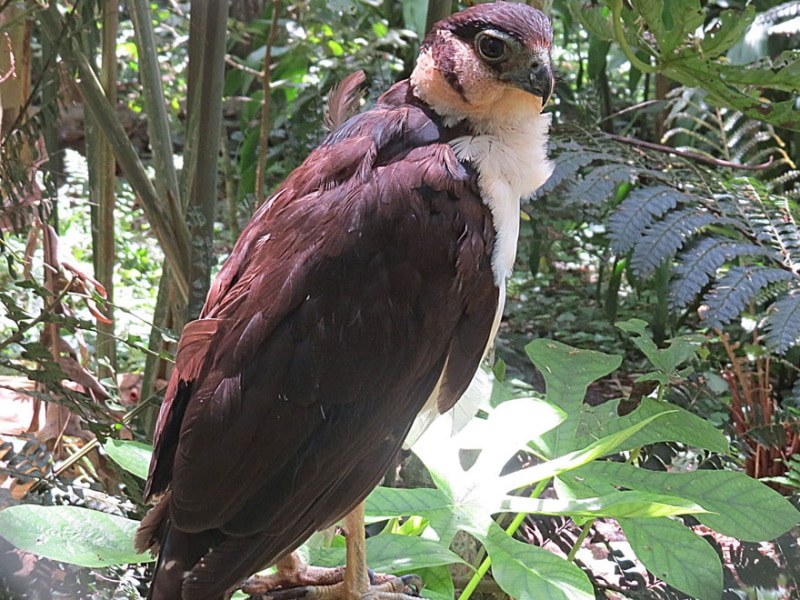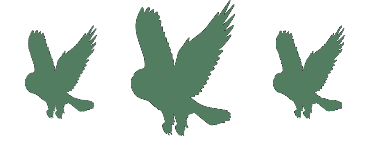Collared Forest Falcon: Field Guide, Pictures, Habitat & Info
Last Updated on

There are thousands of interesting birds in the world, and the Collared Forest Falcon is one of them. Collared Forest Falcons belong to the Falconidae family and are the largest Micastur genus. These birds are widespread throughout South America and Central America, hiding in dense forest canopies and waiting for prey.
Since the Collared Forest Falcon is a unique bird, we want to provide you with more details about its habitat, diet, and lifestyle.
Keep reading to find out more about Collared Forest Falcons and their lives.

Quick Facts about Collared Forest Falcons
| Habitat: | Central and South America |
| Diet: | Birds, mammals, lizards, snakes, insects |
| Nesting: | They typically use tree cavities as their nests. The breeding season starts in January and lasts until March. |
| Conservation: | Least concern |
| Scientific name: | Micrastur semitorquatus |
| Lifespan: | 13 – 20 years |
Collared Forest Falcon General Description

Collared Forest Falcons are large, dark-colored birds you can find throughout Central America and South America. The birds are the largest of their genus, and their size can vary:
- Overall length: 18 – 32 inches
- Wingspan: 28 – 34 inches
When it comes to their size, the females are larger than the males, which is how you can differentiate them. Typically, these birds come in three morph variations:
- Dark
- Pale
- Tawny
Their heads and backs have dark plumage, while their necks and bellies are pale or white. Collared Forest Falcons also stand out because of their large eyes and small beaks pointed downwards.

Collared Forest Falcon: Range, Habitat, Behavior, Diet & Nesting
Knowing how the Collared Forest Falcon looks is not enough to help you identify the bird and learn how to recognize it. Because of that, it’s also helpful to know more about their range, habitat, behavior, diet, and nesting.
Range
When it comes to their range, Collared Forest Falcons are widespread throughout Central America and South America. To be more precise, you can find this bird in the following countries:
- Belize
- Costa Rica
- El Salvador
- Guatemala
- Honduras
- Mexico
- Nicaragua
- Panama
- Ecuador
- Argentina
- Bolivia
- Brazil
- Colombia
- Guyana
- Paraguay
- Peru
- Suriname
- Venezuela
Since these Falcons are adaptable, their range goes from sea level up to elevations of 2,500 meters or even higher.

Habitat
The Collared Forest Falcon is an adaptable bird with multiple habitats. You’ll spot this bird in mangroves, tropical forests, rainforests, shrubby regions, and forest edges. It prefers areas with dense vegetation, as it can easily find nesting spots and food.
Behavior
Falcons use various hunting techniques, from ambushing, flying from perch to perch, or even running on the ground to catch their prey. They have a unique call you can typically hear at dusk or dawn. Sometimes, Collared Forest Falcons can follow ant colonies to capture invertebrates.
Diet
Collared Forest Falcons are not picky eaters, and they feed on all kinds of prey, from birds, mammals, large invertebrates, and small reptiles.
Nesting
These birds typically nest in large cavities inside trees; their favorite tree for nesting is the Spanish Cedar Tree. The female and male build the nest together, but the female is the only one in charge of incubation. During that time, the male provides food for the female and protects the nest from predators.
The female commonly lays two eggs, and the nestlings hatch 45 days after the incubation has started. The young remain with their parents for around 2 months until they’re ready to fly and feed themselves.

How to Find Collared Forest Falcons: Birdwatching Tips

If you like birdwatching and want to see a Collared Forest Falcon in person, it’s good to know some birdwatching tips that will help you see the Falcon.
What to Listen For?
Collared Forest Falcons have a unique call you can easily recognize in the wilderness. It makes “scree,” “scree,” and “ahr” sounds, and you can typically hear it at dawn. The calls from young birds are a bit softer compared to adults.
What to Look For?
As Collared Forest Falcons like to hide deep inside the trees, you should look at dense forest vegetation. They typically nest in a particular tree species, the Spanish Cedar Tree, so you can also try to locate them that way.
When to Look?
Collared Forest Falcons are non-migratory birds, and as long as you search for them in their natural habitats, you can spot them all year.
How To Spot a Collared Forest Falcon in the Wilderness: Tips & Tricks
By learning some simple tips and tricks, you might be able to spot a collared forest falcon in the wilderness. Here are our tips for spotting this majestic bird:
- Look high up: Collared Forest Falcons love to hide in high, dense trees, so looking high up will allow you to spot them
- Closely listen to their call: These birds have a unique call that you’ll easily recognize in the wilderness
- Look for Spanish Cedar Trees: As Collared Forest Falcons nest in these trees, they might be good-looking spots where you can see them
- Look during dusk and dawn: Collared Forest Falcons are the most active during dusk and dawn
Collared Forest Falcon Conservation: Is this Bird Threatened?
The Collared Forest Falcon is not a threatened bird species, and it’s classified as a species with the least concern. However, the birds prefer to nest in a particular tree, the Spanish Cedar Tree, which is a frequent target for loggers.
As the number of these trees becomes lower every year, there’s a possibility that Collared Forest Falcons will be threatened in the future because they won’t have enough nesting spots.

Final Thoughts
The Collared Forest Falcon is a unique bird widespread throughout various states in Central America and South America. If you ever get a chance, look for these birds in dense forests, and listen for their call to locate them. However, remember to keep your distance since they could potentially be dangerous, although they typically don’t attack humans.
Featured Image Credit: collared forest falcon Micrastur semitorquatus (Dick Culbert from Gibsons, B.C., Canada, via Wikimedia Commons CC BY 2.0)
Table of Contents
- Quick Facts about Collared Forest Falcons
- Collared Forest Falcon General Description
- Collared Forest Falcon: Range, Habitat, Behavior, Diet & Nesting
- How to Find Collared Forest Falcons: Birdwatching Tips
- How To Spot a Collared Forest Falcon in the Wilderness: Tips & Tricks
- Collared Forest Falcon Conservation: Is this Bird Threatened?
- Final Thoughts
About the Author Visnja Radosavljevic
Visnja is a creative, adaptable content writer that covers various topics such as DIY, pets, home improvement, travel, gardening, and more. As a young mom and a college student, she didn’t have enough time to balance her personal and work life, so after multiple years of working a regular 9 to 5 job, she decided to pursue her passion and make a living out of it. She has been writing for a couple of years now, helping people to find valuable and interesting information online.
Related Articles:
10 Types of Hummingbirds in Arkansas (With Pictures)
8 Types of Hummingbirds in Nebraska (With Pictures)
5 Types of Hummingbirds in Idaho (With Pictures)
3 Types of Hummingbirds in Mississippi (With Pictures)
8 Types of Hummingbirds in Kansas (With Pictures)
5 Types of Hummingbirds in West Virginia (With Pictures)
5 Types of Hummingbirds in Ohio (With Pictures)
Where Do Nuthatches Nest? Nuthatch Nesting Habits Explained
